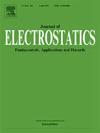微放电等离子体在孔隙中的产生:脉冲电压参数的影响
IF 1.9
4区 工程技术
Q3 ENGINEERING, ELECTRICAL & ELECTRONIC
引用次数: 0
摘要
多孔催化剂在固氮、化学合成、环境污染物处理等等离子催化过程中有着重要的应用。了解孔隙中微放电的产生机理对于设计适用于等离子催化过程的催化剂至关重要。本文建立了一个二维流体模型来模拟常压下孔隙中的微放电特性,主要关注脉冲电压参数的影响,包括电压幅值、脉冲上升时间、脉冲宽度和脉冲极性。结果表明,脉冲极性对微放电的产生有显著影响。与负脉冲电压相比,在电介质上施加正脉冲电压会使气体电离率和总离子密度更高,电子密度和电子温度也更高,从而促进孔隙中微放电的形成。此外,高脉冲电压幅值更容易在孔隙中产生微放电,而脉冲上升沿时间和脉冲宽度主要影响电子密度和电子能量。随着上升时间的增加,电子密度会显著增加,电子温度也会略有上升。此外,脉冲宽度越短,电子温度和电子能量越高。较高的脉冲电压、较短的脉冲上升时间和较窄的脉冲宽度可以在孔隙内部和附近产生较强的电场,有利于在孔隙中产生微放电。本文章由计算机程序翻译,如有差异,请以英文原文为准。
Generation of microdischarge plasma in a pore: Effect of the pulse voltage parameters
Porous catalysts have important applications in plasma catalysis processes for nitrogen fixation, chemical synthesis, environmental pollutant treatment, and others. Understanding the generation mechanism of microdischarge in the pores is crucial for designing the catalysts suitable for plasma catalysis processes. In this paper, a two-dimensional fluid model was established to simulate the microdischarge characteristics in a pore at atmospheric pressure, mainly focusing on the effect of pulse voltage parameters, including voltage amplitude, pulse rise time, pulse width and pulse polarity. The results show that the pulse polarity significantly affects the production of microdischarge. Compared with negative pulse voltage, applying positive pulse voltage on the dielectric results in higher gas ionization rate and total ion density, and electron density as well as electron temperature are higher, which can promote the formation of microdischarge in the pore. In addition, high pulse voltage amplitude is more likely to produce microdischarge in a pore, while the pulse rising edge time and pulse width mainly affect electron density and electron energy. With the rise time increasing, the electron density increases significantly, and the electron temperature rises slightly. Moreover, the shorter the pulse width, the higher the electron temperature and electron energy. Higher pulse voltage, shorter pulse rise time and narrower pulse width can result in stronger electric field in and near the pore, benefiting the generation of microdischarge in a pore.
求助全文
通过发布文献求助,成功后即可免费获取论文全文。
去求助
来源期刊

Journal of Electrostatics
工程技术-工程:电子与电气
CiteScore
4.00
自引率
11.10%
发文量
81
审稿时长
49 days
期刊介绍:
The Journal of Electrostatics is the leading forum for publishing research findings that advance knowledge in the field of electrostatics. We invite submissions in the following areas:
Electrostatic charge separation processes.
Electrostatic manipulation of particles, droplets, and biological cells.
Electrostatically driven or controlled fluid flow.
Electrostatics in the gas phase.
 求助内容:
求助内容: 应助结果提醒方式:
应助结果提醒方式:


